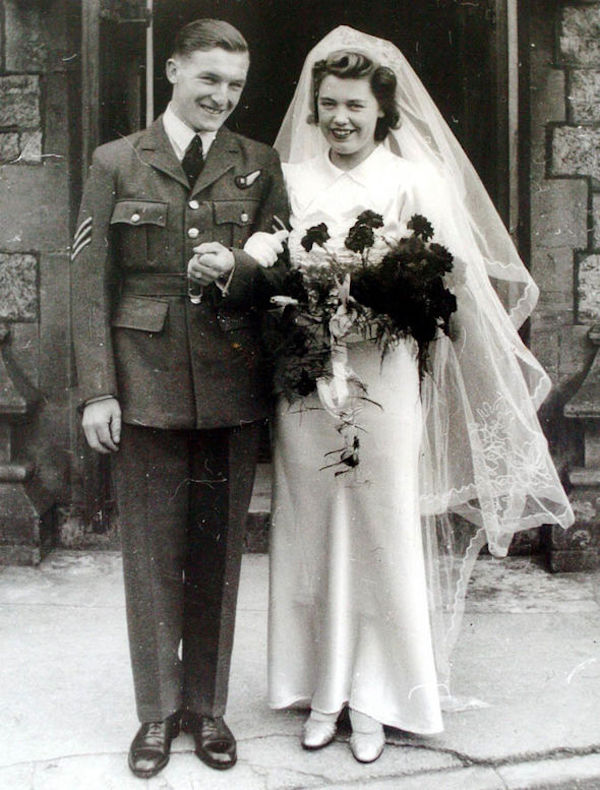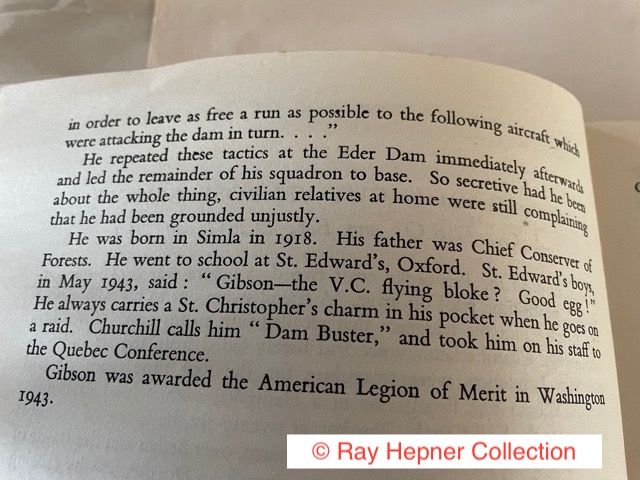
Pic: RAFBF
Sqn Ldr George Leonard ‘Johnny’ Johnson MBE DFM turns 100 this week, on Thursday 25 November 2021. Although he is best known to the public for his role in the Dams Raid in May 1943, he has led a long and interesting life both before and after that historic couple of months.
He was born on 25 November 1921 in Hameringham, Lincolnshire, the sixth and youngest child of Charles and Ellen Johnson. Although his first name was George he was known as Leonard to his family, but when he joined the RAF he was nicknamed ‘Johnny’, and this is the name by which he has been mostly known for the rest of his life. His father was a farm foreman, living in a tied cottage, and the family grew up in very poor conditions. His mother died when Johnny was three, and after this his family life was very disrupted, due to his father’s abusive nature. However, when his older sister Lena moved back home for a while the situation improved and he went to a local primary school in Winthorpe.
At the age of 11 he was sent as a boarder to the Lord Wandsworth Agricultural College in Long Sutton, Hampshire. At the time, this was run by a charity catering for the children of agricultural families who had lost one or both parents. He did reasonably well at school and passed the School Certificate as well as playing cricket and football to a good standard, and winning several athletics events. When he left school in December 1939, he started work as a park keeper in Basingstoke.
Johnny volunteered to join the RAF in June 1940 and eventually joined up in November that year. He was posted to various training establishments but there was some compensation for all the moving around – at one in Torquay, he met Gwyn Morgan, the woman who would later become his wife.
Finally qualified as an air gunner, in July 1942 Johnny was posted to 97 Squadron at Woodhall Spa. He was designated as a spare gunner, without a regular crew, and so he flew with various skippers if one of their own gunners went sick. His first operation was on 27 August 1942, flying with Sqn Ldr Elmer Coton on a trip to Gdynia in Poland. However, an engine failure en route led to an early return, so the first time he saw action was the following day, on an operation to Nuremberg.
Johnny flew on a few more operations but then the opportunity came up to train as a specialist bomb aimer. He took up the chance and completed the course in late November 1942. Within a month, a vacancy for a bomb aimer came up in Joe McCarthy’s crew. McCarthy was an American who had crossed the border to enrol in the Royal Canadian Air Force in order to join the war while the USA was still at peace. At first Johnson wasn’t keen on flying with an American captain, but a conversation with McCarthy changed his mind, and he was introduced to his future crewmates. What united them, he wrote later, was the fact that they all had inbuilt confidence in McCarthy, whom they regarded as the best pilot on the squadron.
Johnson went on nineteen operations with McCarthy, which brought him to the end of a full tour with 97 Squadron. Knowing that he would then be entitled to some leave followed by six months working in a non-combat training role, he and Gwyn arranged their wedding for 3 April 1943. However, the ceremony was nearly called off when the whole crew were transferred to 617 Squadron for a new secret mission and all leave was cancelled.
Their new CO, Guy Gibson, however granted them four days leave when McCarthy insisted. Several other crews had been told by their previous COs that they could take leave before their new posting, but this strategy had not been suggested to the boys from 97 Squadron.

Johnny and Gwyn on their wedding day, 3 April 1943. [Pic Johnson family]
As he has described on a number of occasions, Johnson and his crew dropped their mine as instructed on the Sorpe Dam but failed to breach it. McCarthy, Johnson and their navigator Don MacLean were all decorated for their part in the raid. Johnson received the DFM and travelled up to Buckingham Palace for the investiture. At that point in his life he was a non-drinker, so he didn’t participate in the festivities that followed.
Johnson was commissioned in November 1943 and went on to fly with McCarthy on all his next eighteen operations with 617 Squadron, up until April 1944. At that point, knowing that Gwyn Johnson was shortly to have their first child, McCarthy insisted that he stand down.
Reluctantly, Johnson agreed and was sent back to RAF Scampton as a bombing instructor and served out the rest of the war in various training jobs. After the war, he was told that if he qualified as a navigator, he would get a permanent commission. He accepted this offer, and stayed in the RAF until 1962, retiring with the rank of Squadron Leader.
Now in his forties, Johnson was without a job. So he retrained again, this time as a teacher. He worked first of all in primary schools and then later in adult education, including a period teaching psychiatric patients at Rampton Hospital.
When he retired, he and Gwyn moved to Torquay, where Gwyn had been brought up. Although she came from a Welsh mining family brought up in the Labour tradition, she was a keen Conservative, a strong admirer of Margaret Thatcher. ‘The lady’s not for turning’ became Gwyn’s own catchphrase, used to settle any minor family disputes. The pair had been active in local Conservative Party politics for a while, but after the move to Torquay Johnny was elected as a councillor, and became chair of the constituency party, having to deal with the wayward activities of their local MP when he plotted against Prime Minister John Major. Johnny also took part in reunions and other activities relating both to 617 Squadron and the wider world of Bomber Command, and the pair were very happy with frequent visits from their growing numbers of grandchildren.
However, this came to an end when Gwyn was diagnosed with cancer and spent the last eighteen months of her life in declining health.
Gwyn Johnson died in August 2005 and for a while Johnny withdrew from public life. I first spoke to him a year or two later, while researching my book about the life of David Maltby and his crew, and he told me then what a terrible blow it had been. Shortly afterwards, he started accepting invitations from the media for interviews and documentary appearances. As the number of Bomber Command veterans have inevitably dwindled over the last fifteen years he has become one of its most familiar faces. Johnny is still a compelling speaker and a willing interviewee, although these activities have necessarily been restricted in recent times.
He has always worked hard for charity, particularly campaigning for improved resources for mental health, and this was recognised in 2018 with the award of an MBE, an honorary doctorate at the University of Lincoln (back in his home county) and a flight over the Derwent Dam in the Battle of Britain Memorial Flight Lancaster. His public appearances during this period always resulted in a steady stream of people wanting to shake his hand and take a selfie.
Like many of the generation which came of age during the war years, Johnny has always said that he was simply doing his job. The fact that by doing this he was risking his life, defending liberty against those who sought to bring tyranny to these shores, is immaterial. The qualities by which he has lived his first one hundred years are those of honesty, discipline, respect and loyalty. As he enters his second century let us all wish him the best, and hope that he has many more years to devote to his service to the nation.






